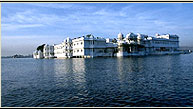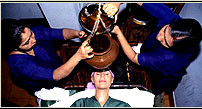-| Ajanta | -
Location: District – Aurangabad - 20º 32'N, Long 75º 45'E

These world famous caves are situated 104 kms. from Aurangabad and 52 kms. from
Jalagaon railway station. The Ajanta caves are 32 in number including unfinished
ones and dating back to 200 BC to 9th century AD. The mural paintings occupy
a unique position among the monuments of India. The superb symphony of architectural
form, sculptures and paintings are unique in the world.
The caves are cut from the volcanic rock known as Deccan trap rock in the forest
and ravines of the Sahyadari hills and are set in beautiful tranquil surroundings.
They were rediscovered accidently by a British captain in early 19th century
AD, who went on a hunting expedition. Ajanta caves provided a unique combination
of monastic architecture, the Chaitya or prayer hall ( caves 1 to 5 -9,10,19,26
& 29 ) and Vihara or Monastery (remaining twenty four caves).
These caves suggest a well defined form of architecture broadly ranging around
four centuries. In the early phase, the Hinayana caves include two chaityas
(cave no. 9 & 10) and four viharas (cave no. 8,12,13 & 15A). The later
phase or the Mahayana phase are represented by two chaityas (cave no.1 to 5,
19, 26 & 29 being incomplete) and eleven exquisite viharas ( cave no. 1,2,4,6,7,11,15,17
and 20 to 24). The Ajanta sculptures of the Mahayana phase established a formal
religious imagery, whereas the Hinayana monuments at the site are virtually
devoid of carvings.
Cave no.-1 is one of the finest monasteries and the interior paintings
here are among the greatest at Ajanta. Graciously posed as Bodhisattvas, namely
Padampani and Vajrapani with elaborate dresses flank the ante-chamber doorway.
The wall on the side of ante-chamber depict assault and temptation by Mara (
The Demon ) and the miracle of Sravasti. Scenes from the Jataka tales are depicted
on the walls of the caves.
Cave no.2 monastery repeat the basic scheme of cave 1 and is also memorable
for its painted ceiling.
Cave no,9,10,12 & 15 A are chaitya halls
of Hinayana phase.
Cave 10 is the among the first excavated the site
and is one of the most impressive
cave. 14,15 & 16 are vihara belonging
to the Mahayana phase.
Cave 17 is a vihara preserving the greatest number
of wall paintings including a row of eight Buddhas.
Cave 19 is perfectly
excavated small monastery in which the ante-chamber protrude into the hall and
there are no columns.
Cave 21 to 24 represent the last example of work at Ajanta.
Cave 26
is a Chaitya - a hall larger than that of
cave 19, but it is otherwise
smaller in its arrangement and decorative scheme. The caves are cut in the crescent
shaped bend of a steep rock overlooking the head of a narrower glen which provides
a fantastic view.




